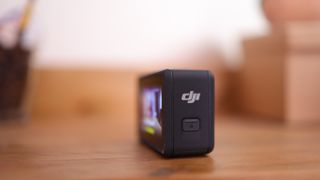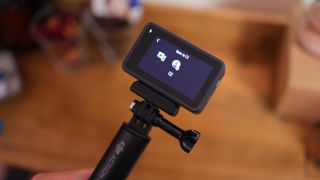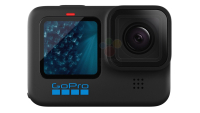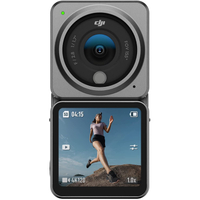TechRadar Verdict
Undercutting much of the competition, the DJI Osmo Action 3 may not be the best action camera available, but it could be the best value option for you. It dives deeper than the competition with waterproofing up to 16m, has a wider field of view, and delivers excellent battery life. While it recycles the same core camera hardware we saw in the Action 2, its more practical body and excellent mounting system also impress – so if you don’t need best-in-class image quality but want a robust, powerful, long-lasting GoPro alternative, DJI’s latest Action could be just the ticket.
Pros
- +
Incredibly convenient mounting
- +
Best-in-class diving depths
- +
Wider FOV than the main competition
- +
Excellent battery performance
- +
Handy front touchscreen
Cons
- -
Poor lowlight performance
- -
360-degree horizon leveling caps at 2.7K
- -
Worse video quality than the best GoPros
- -
Photography modes aren’t competitive
Why you can trust TechRadar
Two-minute review
It's back to the future for DJI's action camera line, as the new DJI Osmo Action 3 brings back the 'Osmo' name and traditional action camera styling – both features missing in last year's DJI Action 2. That means removable batteries, an SD card slot and a swappable lens are all back, making the Action 3 the true successor to the original DJI Osmo Action, when it comes to design at least.
We loved the Action 2's modular and compact form, but it had its limitations – specifically heat management. Thankfully, this time around, DJI has improved things in that department and brought back our favorite Action 2 feature – that excellent mounting system. Adopting a combination of magnets and clamps, you may never have to twiddle a traditional action camera mounting screw again.
But is magnificent mounting and better heat handling enough to fend off competition from the excellent GoPro Hero 11 Black, with its new 8:7 sensor?
Sensor: 12MP 1/1.7-inch CMOS sensor
FOV/focal length: 155º/12.7mm
Max photo resolution: 4000 x 3000
Video: Up to 4K 120fps (16:9)
Stabilization: RockSteady 3.0
Leveling: +/-45º up to 4K, 360º up to 2.7K
Front screen: 1.4-inch, 320x320
Rear screen: 2.25-inch, 360x640
The DJI Osmo Action 3 has more going for it than just convenient mounting. Its wide field of view is more expansive than that of the GoPro Hero 11 Black. Waterproof up to 16m, it can be submerged 6m deeper, and it undercuts the competition too. Available in an excellent Adventure Combo for less money than the standard Hero 11 Black, it's also a value champ, shipping with three extra batteries, multiple mounts, and an extending grip.
GoPro's Hero 11 Black outclasses the DJI Osmo Action 3 when it comes to shooting modes and image quality, and while DJI has some wins, it also fails to outperform its pricier competition with its videos or photos.
Costing less than its main competition, though, and featuring some clear highlights – our favorite being that quick swap mounting system - the DJI Osmo Action 3 is still a compelling option. And while we miss the Action 2's modular design, you can't argue with the fact the Action 3 is a much more practical package.

DJI Osmo Action 3 release date and price
- Available to buy now for $329 / £309 / AU$519 for the base package
- Adventure Combo costs $439 / £399 / AU$719
- Supplements the DJI Action 2 which is still on sale
The DJI Osmo Action 3 is available to buy now for $329 / £309 / AU$519 in its lowest-cost package. DJI has also launched the Adventure Combo for $439 / £399 / AU$719, which combines the camera with a host of mounts, a total of three batteries, and a charging cradle for them, in addition to a grip and portrait-orientation mountable housing.
This price makes the DJI Osmo Action 3 a much more affordable alternative to the new GoPro Hero 11 Black, which starts at $499 / £499 / AU$799 ($399 / £399 / AU$649 with a GoPro subscription). Interestingly, the DJI Osmo Action 3 also undercuts the Action 2, which cost $399 / £349 / AU $609 at launch. In austere times, this could be a smart move from DJI, creating a more value-centric alternative to the pricey action camera competition.
- Price: 4.5/5
DJI Osmo Action 3: design
- Brings back the traditional action camera design of the Osmo Action
- A brilliant magnetic mounting system
- Waterproof up to 16m – besting the competition


The DJI Osmo Action 3 marries the guts of the Action 2 with the styling of the original Action – but it has a few unique updates of its own thrown in for good measure. On first glance, the body is an action-camera-by-numbers. There's a removable lens on the front as well as a front touchscreen, around the back is a larger touchscreen, and to the left and right are sliding doors, which cover the USB-C port on one side, and the battery and SD card slot on the other.
At the base of the Action 3 is a magnetic mounting connector for landscape mounting, and in the box, you also get a Horizontal-Vertical Protective Frame, which wraps around the camera to enable tall, TikTok-ready mounting in portrait orientation.
Generally speaking, DJI has done a great job of making the Osmo Action 3 feel robust, though the lens frame does protrude slightly around the sides of the camera. This could catch in the heat of the action, making it a potential weak point versus the GoPro Hero line, whose lenses are flush with the top and sides of the camera.
The protruding lens could also be a high-impact point if the camera falls, possibly damaging the glass. DJI includes a rubber element around the lens, likely to reduce the risk of damage. It's easy to remove and easy to lose, though, so that's something to be mindful of. On the plus, unlike the Action 2, the Action 3's lens is removable, so if it does get damaged, it can be replaced.

DJI's inclusion of a front touchscreen on the Action 3 can't be overlooked. Historically, front displays on action cameras were only used for framing up shots, but this time around, you can control all the camera's features with your digits when vlogging without having to turn it around.
While the front touch display is cramped at 1.4 inches, the main screen is much more spacious, measuring 2.25 inches. With both screens sporting a pixel density of 326PPI, they're plenty sharp, and they also get nice and bright for easy outdoor viewing.
- Design and handling: 4/5
DJI Osmo Action 3: features and performance
- Smooth and stable touch interface
- Fewer software flourishes than the competition
- Improved heat management versus DJI Action 2
The DJI Osmo Action 3 brings back the same interface we got in the Action 2 – it was smooth and stable last year, and it's smooth and stable now. Large, finger-friendly icons make interaction intuitive, and there's a simple enough menu system too.
Where the DJI Action 2 dropped the ball was heat management. Its small body and exposed metal design resulted in uncomfortably hot temperatures after even short bouts of recording high-resolution content. This time, though, DJI has improved things significantly.
The Action 3 can record for longer bouts than the Action 2 could without overheating, shooting a 16-minute 30-second 4K clip at 60fps before stopping recording. Even when it did overheat, the camera wasn't uncomfortably hot to the touch. This doesn't outclass the new GoPro Hero 11 Black, which records for more than 10 minutes longer at the same resolution and frame rate, however, it is a huge improvement over the Action 2.



The Action 3 doesn't have quite as many software flourishes as the GoPro Hero11 Black, especially when it comes to photography. There isn't even a night mode, so the ultra-wide angle lens on your smartphone will likely capture a superior lowlight photo than DJI's camera. With computational photography having come so far in recent years, and GoPro clearly paying attention, the Action 3's weak photo capture -especially in challenging scenes - is a noteworthy drawback.
One area DJI does edge ahead, however, is with its app, DJI Mimo. Just like GoPro Quick, DJI's app offers big-screen control over modes, which is handy, as well as a live preview of whatever you're shooting. We found DJI Mimo to be more reliable than GoPro Quick during our time with the camera – it doesn't try to do quite as much, but in the process, delivers a more stable connection with lower latency.


DJI makes its interface extremely customizable. For starters, you can save up to five custom profiles so you can quickly switch between bespoke shooting modes. You can also add these modes to your Quick Switch command – activated by a single, short-press of the power button.
DJI also opens up a range of Pro features. When capturing photos, you can shoot in JPEG or RAW, switch between a wide or standard field of view, control shutter speed and ISO, and adjust white balance. On the subject of white balance, under the lens, DJI includes a color sensor to help the camera capture natural-looking hues.
Pro video capture gives users control over white balance, ISO and shutter speed, just like Pro photo, but also offers an extra color profile, D-Cinelike, for flatter tones that gives users more scope to recolor with video editing software.

DJI makes its interface extremely customizable. For starters, you can save up to five custom profiles so you can quickly switch between bespoke shooting modes. You can also add these modes to your Quick Switch command – activated by a single, short-press of the power button.
DJI also opens up a range of Pro features. When capturing photos, you can shoot in JPEG or RAW, switch between a wide or standard field of view, control shutter speed and ISO, and adjust white balance. On the subject of white balance, under the lens, DJI includes a color sensor to help the camera capture natural-looking hues.
Pro video capture gives users control over white balance, ISO and shutter speed, just like Pro photo, but also offers an extra color profile, D-Cinelike, for flatter tones that gives users more scope to recolor with video editing software.


- Features and performance: 4/5
DJI Osmo Action 3: image and video quality
- Shoots at up to 4K 120fps
- Horizon leveling up to 45º at 4K
- 360º horizon leveling at up to 2.7K
If you've used the DJI Action 2, you'll know what to expect from the Osmo Action 3. The cameras share the same characteristics when it comes to both photos and videos. That means that the Action 3 isn't best in class, with performance missing out when compared to both this year's GoPro Hero 11 Black and last year's GoPro Hero 10 Black. That isn't to say video captured on the Action 3 is bad, though.
In brightly-lit environments, you can shoot good-looking, sharp footage from the Action 3 at up to 4K resolution. If you mainly shoot vlogging-style content, and don't need a super-wide 155º FOV, you'd be better opting for a less expansive action camera. The Action 3 doesn't prioritize faces when it exposes a scene, and it also misses out on detail picked up by competing cameras like the GoPro Hero 10 and 11.
By getting more in frame with its wider 155º FOV, DJI also makes it harder to expose the image for all the elements in-frame. As you can see in the sample above, when vlogging, the Action 3 has to contend with a huge amount of sky, and on the other end of the exposure spectrum, dark foreground and background elements in the bottom half of the scene. With its limited dynamic range, matched with the fact it doesn't seem to prioritize faces by default, the Action 3 misses the mark for vlogging.
When you switch out the lens to a less wide field of view, detail falls off, and the camera still underexposes faces. For vloggers, therefore, we'd definitely recommend stumping up for the GoPro Hero 10 or 11 Black with a Media Mod if you know you'll be shooting outdoors in unpredictable situations.
Also illustrated in the above video is horizon leveling, a feature introduced in the Action 2. This keeps footage looking steady, compensating for tilts at up to 45-degree at 4K resolution, and able to handle 360-degree rotation at 2.7K without so much as a tiny sway appearing in your footage.
If the Hero 11 Black hadn't been announced, the Action 3's horizon leveling would have been super-competitive, but now that GoPro's latest action camera ups the ante with its higher-resolution 5.3K 360-degree leveling, DJI's implementation loses some of its shine. It also doesn't do as well in dimly lit scenes, with tilts visible as judders in footage. Given the fact the Action 3 undercuts the competition, though, it's still an excellent feature for the camera's price.
The additional shooting modes on the DJI Osmo Action 3 are exactly what you'd expect from an action camera. You can see an example of a time lapse video above, and it looks good. The example also elegantly communicates the style with which the Action 3 captures content. Enjoyably expansive, though with limited dynamic range and detail versus some of the competition.
As for audio quality, the DJI Osmo Action 3 captures clean sound from its three microphones, tuning out background and wind noise relatively well. We actually prefer the quality of its audio versus the GoPro Hero 11 Black when vlogging, especially if you're out and about.
If you have an excellent wireless DJI Mic, you can easily upgrade your audio quality by simply plugging the receiver straight into the side of the Osmo Action 3.
- Image and video quality: 3.5
Should I buy the DJI Osmo Action 3?
Buy it if...
You love diving
The DJI Action 3 is waterproof up to 16m, outperforming the GoPro Hero 11 Black, which caps out at 10m. This makes it a better choice for divers who don't fancy donning a case. If you don't mind using a case, the Action 3 can dive as deep as 60m.
You need quick mounting
With a few quick-release adapter mounts, you can swiftly mount and unmount your DJI Osmo Action 3 from your favourite tripods, grips, helmets, car bonnets and more. Combining magnets and a clamping system, DJI's mounting system could save you from ever needing to screw your action camera in place with a traditional mounting system ever again.
You want the widest angle available
Despite slightly undercutting the competition, the DJI Osmo Action 3 actually offers a wider angle of view than any GoPro Hero Black, with a 155-degree lens, which works out to 12.7mm, when translated to traditional focal length measurements.
Don'y buy it if...
You're a social media maven
DJI claims its new Osmo Action 3 is perfect for TikTok and Instagram because it can be mounted vertically with a special case. Compared to the GoPro Hero 11 Black, though, which shoots native 8:7 content that's poised to be cropped for all social media platforms, DJI's solution misses the mark. If GoPro hadn't changed the game with its new sensor size, DJI's Osmo Action 3 might have competed, but as it stands, Instagrammers, TikTokers, and YouTubers after multiple edits from one clip should opt for the Hero 11 Black.
You shoot long clips at high quality
The DJI Osmo Action 3 doesn't like shooting long clips at its maximum 4K resolution at 60fps. Capping out at around 16 minutes 30 seconds, while it outperforms its predecessor, it can't best the GoPro Hero 11 Black, which can shoot over 28 minutes with matching quality.
You want the best action camera photography
DJI doesn't dial up its Action 3's photography software anywhere near as much as GoPro does. Whether you're talking about last year's Hero 10 Black or the new Hero 11 Black, GoPro employs computational photography to eke a little extra from its photos. Night Mode, Super Photo – both help with dynamic range on GoPro's cameras, while the DJI Osmo Action 3 falls short in high-contrast situations.
Also consider...
Insta 360 X3
Insta360 has taken the do-it-all 360-degree camera approach of the old One X2 and jazzed it up with a much larger display and slightly bigger camera sensors. Pricier than the Action 3, the Insta360 X3 could be worth it for anyone looking for an improved take on one of the best all-round action cameras.
Read our in-depth Insta 360 X3 hands-on review
GoPro Hero 10 Black
The DJI Osmo Action 3 competes more closely with the GoPro Hero 10 Black thank the Hero 11 Black when it comes price. For anyone who likes the look of GoPro's accessories – the Max Lens Mod, Media Mod and Volta, the 10 Black could be a better shout. It also captures superior stills and does a better job of exposing for faces when shooting vlogging content.
Read our in-depth GoPro Hero10 Black review
DJI Action 2
The DJI Action 3 doesn't carry forward the Action 2's compact form and modular design, and it also doesn't look or feel as premium or stylish. While the Action 3 is a much more practical camera, handling heat better and lasting longer, and it's more robust too, anyone who prioritizes style above all else might be better served with last year's Action.
Read our in-depth DJI Action 2 review
Testing scorecard
| Attributes | Notes | Rating |
|---|---|---|
| Price | A great value package for anyone who wants quick mounting and deep diving capabilities | 4.5/5 |
| Design | Traditional styling is back and it's very practical – but the Action 3 isn't as innovative as its predecessor | 4/5 |
| Performance | The Action 3 is smooth to use, enjoyes improved battery life and better heat management than the Action 2 | 4/5 |
| Image and video quality | Good video quality and mediocre photo quality make the DJI Osmo Action 3 is best suited for anyone looking to record clips of under 15 minutes | 3.5/5 |
Basil Kronfli is the Head of content at Make Honey and freelance technology journalist. He is an experienced writer and producer and is skilled in video production, and runs the technology YouTube channel TechEdit.






